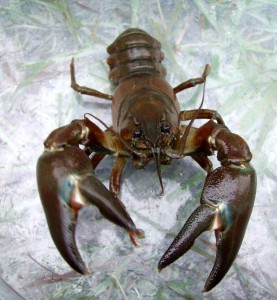
SCOTLAND’S remaining freshwater pearl mussels face a potentially “mortal” threat from invading crayfish, scientists revealed today.
American signal crayfish have rampaged through the nation’s rivers in recent decades and now directly threaten the critically-endangered mussels.
Scottish Natural Heritage (SNH) say crayfish are now just 20 miles away from a colony of freshwater pearl mussels in the Tay.
Experiments carried out at Stirling University have demonstrated that crayfish cause death and destruction when they are unleashed in the mussels’ habitat.
Scotland has half the world’s population of the molluscs, which can live to be more than 100.
They have been hunted close to extinction on the off chance they contain a pearl, and are sensitive to pollution.
The precise location of surviving colonies is publicised as little as possible to give the mussels’ numbers a chance to recover.
But SNH’s freshwater advisor, Dr Colin Bean, said they now had evidence of a ‘mortal’ threat to the rare mussels.
He said: “Upstream in the River Earn, there are crayfish around Comrie.
“You get mussels as far down as Perth.
“They haven’t clashed yet on the Tay, but there is a threat given how fast they spread.
“It might be a few years off – but it’s not far away.”
Dr Bean said that after identifying the risk, SNH wanted to look into in to what would happen when the creatures met.
He said: “We put the two of them in tanks, looking at the behaviour of the crayfish.
“What we saw was them disturbing the mussels, throwing them around.”
Dr Bean said this could harm the mussels, as it separated them from the river sediment where they thrive.
“The potential for mortality is greater than if they are left alone,” he said.
Dr Bean said their “world-leading” study was now looking at whether crayfish could get “access to the meaty part” of the mussels and devour them.
“In Germany it was found crayfish had damaged the valves of pearl mussels, suggesting they did try to get into them,” said Dr Bean.
Zara Gladman, a PhD student at Glasgow University, carried out the studies in a series of tanks at Stirling University.
She said: “The mussels are very endangered – Scotland has half the world’s population.
“As far as I know they haven’t invaded where they are now, but they are in the same river sections.”
She agreed with Dr Bean that the invaders may develop a taste for mussels if they can get their claws into them.
“Based on what we know about what crayfish like to eat, they might be quite tasty for them,” she said.
Crayfish have colonised around 100 miles of Scottish rivers since they were accidentally introduced 17 years ago. Until now, salmon were considered the primary species at risk.
Dr Bean said: “Signal crayfish were first brought to Britain largely for agrarian purposes, but they spread very quickly.
“They were first recorded in Scotland in 1995. Now they occupy 170km of streams and rivers.”
He admitted: “It’s going to be impossible to eradicate them, but we are still looking at ways to control them.”
Dr Peter Cosgrove, of Aberdeen-based ecological consultancy Alba Ecology, is an expert on freshwater pearl mussels.
After studying the creatures for 16 years, he said it would be a ‘disaster’ if crayfish invaded pearl mussel colonies.
He said: “It wouldn’t take the crayfish long. On the day they’re introduced they will forage prominently on the bottom of the river.
“On day one you would see mussels being clobbered by crayfish.
“The juveniles would be directly killed because they can crack their shells open. The adults would dies slowly from being pinched and cracked.
“They would hurt their breeding capabilities.”
Although her findings are not yet conclusive, Ms Gladman’s research in to the spread of crayfish is pointing towards a “grim” conclusion.
On average three new populations of crayfish have been found annually since 1995, and government sponsored drives to eradicate them have been met with failure.
Ms Gladman found a bid to eradicate crayfish from Loch Ken in 2009 failed to clear the crustaceans from the water.
The smaller females slipped through trappers’ nets, meaning they were free to breed again and spread their young throughout the loch.
They are also thought to be moving downstream on the Clyde towards Glasgow from their current base near Crawford. The creatures have also been found in the River Kelvin a few miles from the city centre.
A barrier was set up to prevent their spread to the river Annan last year, but it remains to be seen how successful it has been.
Experts are urging river users to do all they can to help stop the spread of the crayfish.
Anglers are being advised to wash all their equipment carefully to avoid spreading crayfish young from one river to another.
Ms Gladman said anyone who picked up a crayfish was obliged by law to kill it immediately.
“If you pick up a signal crayfish, you have to kill it immediately, if you put it back you’re re-introducing it to the wild,” said Ms Gladman.

